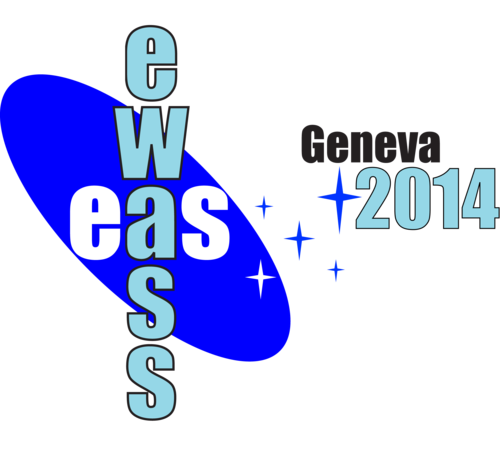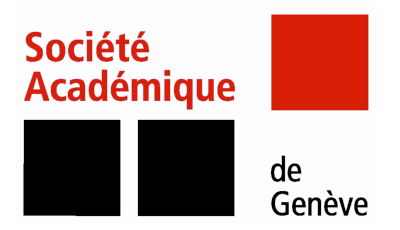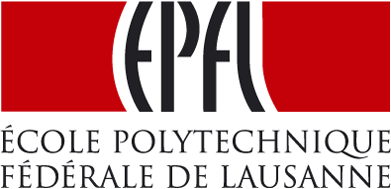|
EWASS 2014 : European Week of Astronomy and Space Science 30 June – 4 July 2014, Geneva, Switzerland |
|||||||||||||||||||||||||

|
Symposium S7
30 June – 1 July 2014
Fast outflows in massive stars: from single objects to wind-fed and colliding-wind binariesNews:
Massive Stars are among the dominant sources of light in galaxies. Their high surface temperature, maintained over several evolutionary phases, implies that most of this light is emitted as ultraviolet photons. Through line scattering and the corresponding momentum transfer, this intense radiation field is able to accelerate fast outflows.
Observations of massive stars proved that such outflows can reach terminal velocities up to 3000 km/s and carry away with them about ~1E-7 to few 1E-5 solar masses per year. These stellar winds are far from being stationary and homogeneous. Both observations (of close-by isolated massive stars) and theory provide compelling evidence that instabilities develop fast during the expansion of the wind, leading to the formation of compressed "clumps" that are immersed in a background of much lower density. This scenario has been confirmed by 1D and 2D radiation-hydrodynamical simulations. Recent 3D empirical models allow to include a much wider phenomenology related to the formation, merging and disruption of the clumps.
Beside observations of the limited sample of bright nearby massive stars, additional constraints on the physical properties of their fast winds have been recently inferred from X-ray data of wind-fed high mass X-ray binaries (HMXBs). In these systems, a compact star (a neutron star or a black hole) orbits around the massive companion and accretes material from its wind. Starting from the early 90's, a number of theoretical studies and hydrodynamic simulations have tried to interpret the strong variability of these objects in the X-ray domain in terms of inhomogeneities in the accreting environments, thus strongly linking the stellar and the X-ray communities. The link between the two communities has become stronger and stronger in the very past few years, thanks to the discovery of a number of peculiar wind-fed and strongly variable systems (the so-called highly obscured HMXBs and the Supergiant Fast X-ray Transients). The properties of the massive star winds inferred from X-ray observations of these objects challenge previous theoretical models and provide new insight into the structure of stellar winds.
Whenever two massive stars find themselves bound by gravitation in a binary systems, the interaction between their highly energetic and supersonic winds gives rise to shocks and thus conspicuous emissions spanning from radio to Gamma-rays. These "Colliding Wind Binaries" have also been widely investigated to probe the structure and properties of their fast and possibly clumpy outflows. In these systems, the density contrast and size of the clumps can significantly increase the turbulence in the shock region and enhance non-thermal emission detectable up to Gamma-rays. The spectrum of the emitted electromagnetic radiation depends critically on the physical properties of the clumps.
Massive stars are also the key ingredient in Gamma-ray binaries, producing very high energy emissions detected up to >100 GeV and opening new opportunities to study particle acceleration, magnetized relativistic outflows, and accretion-ejection physic. The symposium we propose here aims at bringing together specialists from different adjacent fields to summarize the state-of-the-art of the theoretical/simulation modeling of fast outflows in these objects and proceed towards a unified view able to explain the multiwavelength data. Invited speakers
Scientific organizers E. Bozzo (ISDC, Switzerland), S. Martínez Núñez (Univ. of Alicante, Spain), P. Kretschmar (ESA/ESAC, Madrid), J. Puls (Univ. of Munich, Germany), L. Oskinova (Univ. of Potsdam, Germany), R. Walter (ISDC, Switzerland), J. Pittard (Univ. of Leeds, UK), A. Neronov (ISDC, Switzerland), C. Ferrigno (ISDC, Switzerland), M. Falanga (ISSI, Bern) Contact Updated on Thu Apr 17 16:53:54 CEST 2014
|
||||||||||||||||||||||||
| EWASS 2014 : European Week of Astronomy and Space Science | |||||||||||||||||||||||||
 A power cut will shut down all EAS services on Tuesday, 10 January 2017 starting at 7:30 CET.
A power cut will shut down all EAS services on Tuesday, 10 January 2017 starting at 7:30 CET.


















